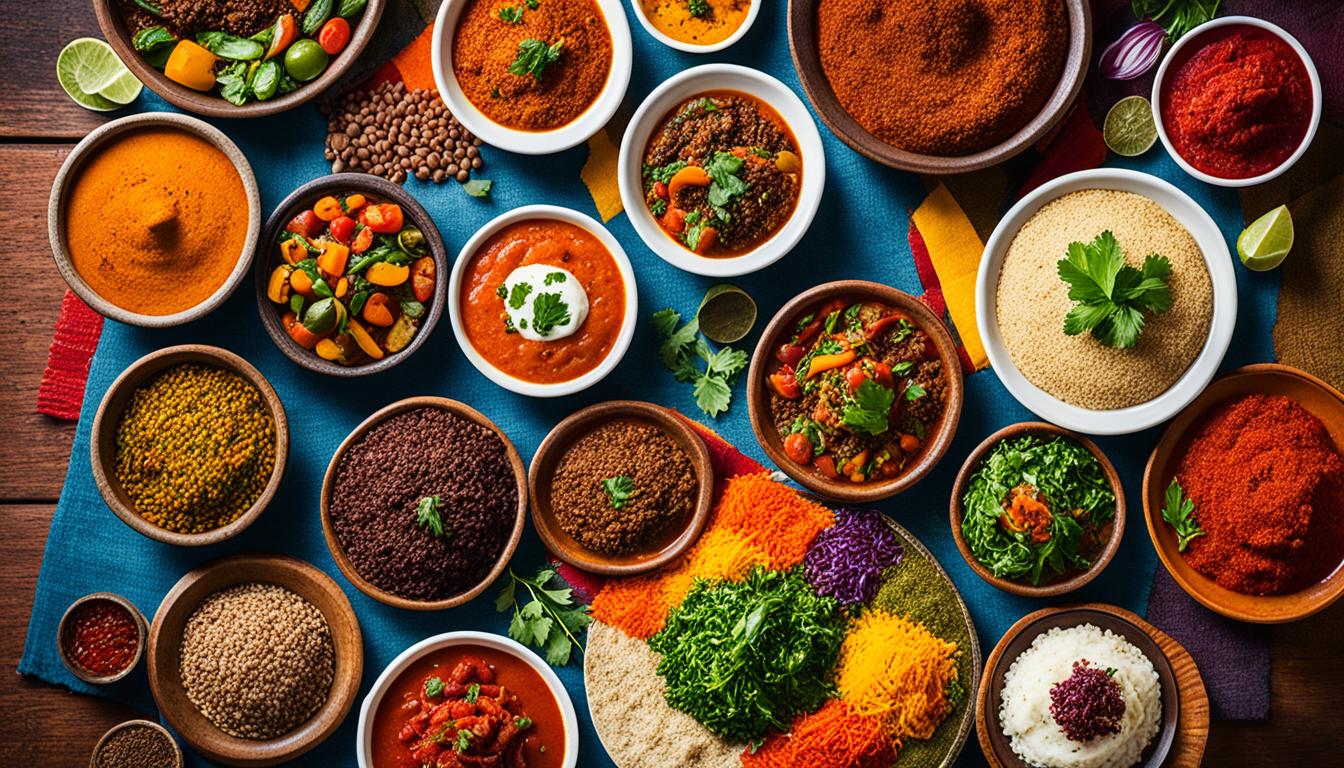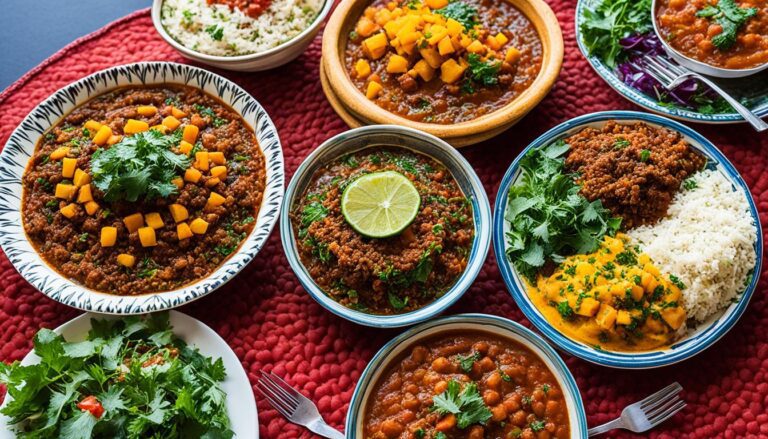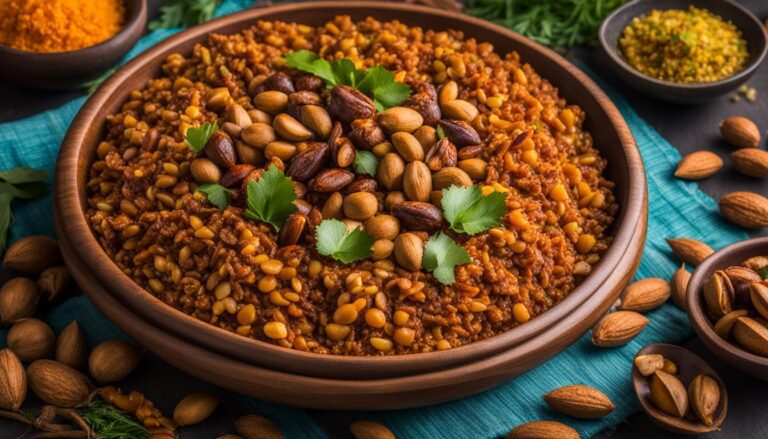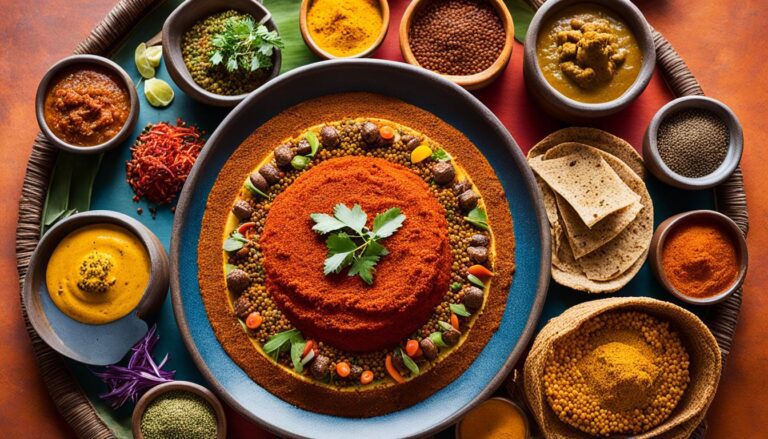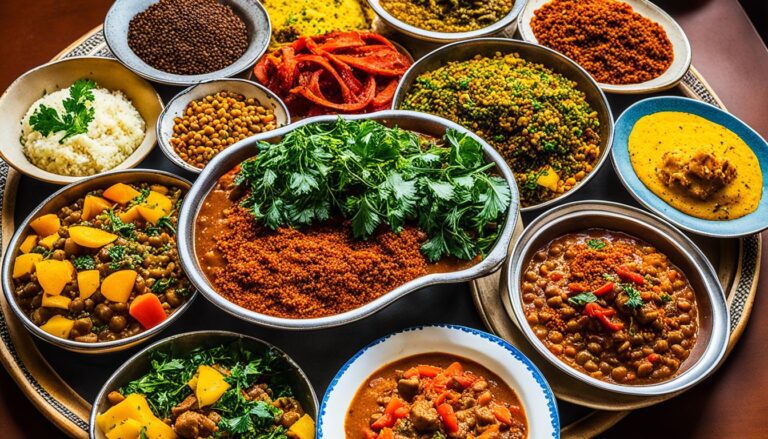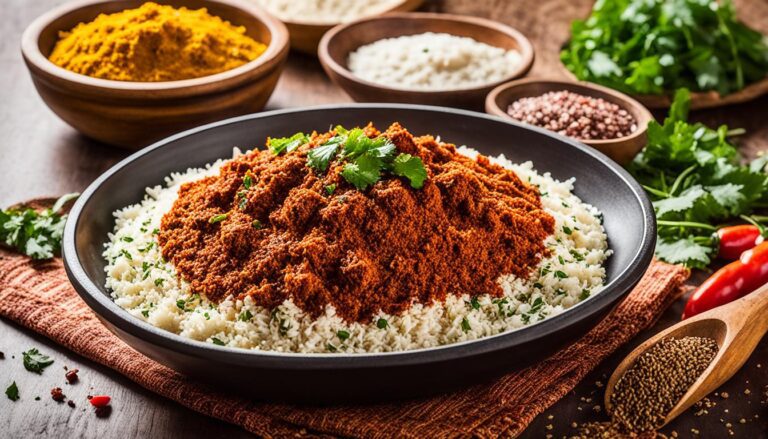What Is Special About Ethiopian Food?
When it comes to discovering new cuisines, we often crave flavors that transport us to distant lands and leave a lasting impression. Ethiopian food is one such cuisine that promises an unforgettable culinary experience. But what sets it apart from other African cuisines? What makes Ethiopian food so special?
Exploring the vibrant and diverse culinary traditions of Ethiopia reveals a world of unique flavors and communal dining practices that challenge our preconceived notions. From the spongy bread called injera to the bold spices and vegetarian-friendly options, Ethiopian cuisine is a treasure trove waiting to be explored.
Join us on a journey as we uncover the secrets of Ethiopian food, delving into its communal dining experience, the staple of Ethiopian cuisine – injera, the bold spices that tantalize the taste buds, and the variety of must-try dishes that will transport you to the heart of Ethiopia.
Key Takeaways:
- Ethiopian food stands out with its unique and unforgettable flavors.
- The communal dining experience in Ethiopia creates a sense of togetherness and shared enjoyment of food.
- Injera, the spongy bread, is the staple of Ethiopian cuisine and adds a unique element to the dishes.
- Ethiopian food is renowned for its bold spices and flavors.
- Ethiopian cuisine offers a wide range of options for vegetarians and vegans.
The Communal Dining Experience of Ethiopian Food
When it comes to Ethiopian cuisine, it’s not just about the delicious flavors – it’s also about the unique dining experience. Ethiopian-style dining is all about communal eating and the sense of togetherness it brings.
Picture a large circular tray called an injera, placed at the center of the table. It’s not your typical dining table setup, but that’s what makes Ethiopian dining so special. On the injera, you’ll find an array of dishes, including spicy stews, flavorful vegetable curries, and even raw meat for the adventurous eaters.
But here’s the twist – instead of using cutlery, Ethiopians use torn pieces of injera to scoop up the food. The injera acts as both a plate and utensil, adding a unique element to the dining experience. This hand-feeding tradition is a sign of respect and love, often seen in couples feeding each other.
The communal nature of Ethiopian dining encourages conversation, laughter, and the shared enjoyment of food. It brings people closer together, creating a sense of unity and connection. Sitting around the injera, friends and family engage in lively conversations while savoring the flavors of Ethiopian cuisine.
The Significance of Injera in Ethiopian Dining
Injera isn’t just a piece of bread, it’s the heart and soul of Ethiopian dining. Made from fermented teff flour, injera has a slightly sour taste that complements the flavors of the dishes it accompanies.
As the base of the meal, injera serves as a canvas for the various stews and curries that are piled on top. Its spongy texture soaks up the flavors, creating a harmonious medley of tastes with every bite.
So, next time you find yourself at an Ethiopian restaurant, be sure to embrace the communal dining experience and try hand-feeding yourself with injera. Let the flavors of Ethiopia transport you to a world of vibrant traditions and unforgettable cuisine.
The Staple of Ethiopian Cuisine – Injera
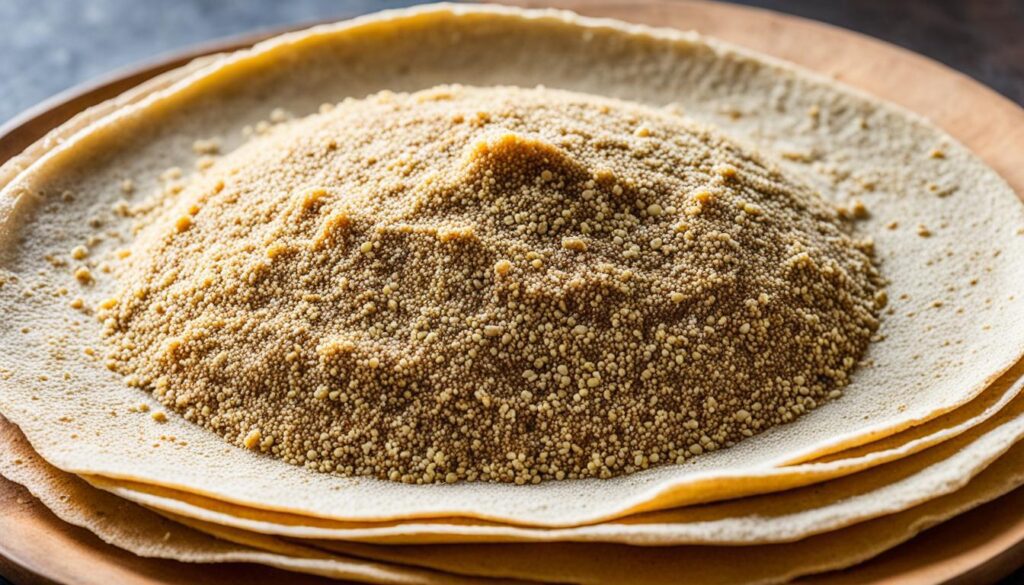
Injera, the Ethiopian cuisine staple, is a beloved and essential part of Ethiopian dining. Made from teff flour, a grain indigenous to Ethiopia, injera holds a prominent place in every Ethiopian meal. The process begins with fermenting teff flour batter, which is then cooked on a skillet, resulting in a soft and spongy texture that is characteristic of injera. With its lightly sour flavor, injera complements the bold spices and flavors found in Ethiopian dishes, creating a harmonious culinary experience.
Traditionally, injera is served as a base on a large platter, with a variety of stews and curries placed on top of it. This communal way of dining reflects the Ethiopian culture’s emphasis on sharing and togetherness during meals. The injera acts as an edible utensil, allowing diners to scoop up their chosen dishes and savour the complex flavors in each bite. Its unique texture and taste make injera an integral part of Ethiopian cuisine.
Whether you are a fan of meat, vegetables, or legumes, injera serves as the perfect vessel to enjoy the diverse and flavorful dishes of Ethiopian cuisine. Its sour flavor balances the spiciness and richness of the Ethiopian spice blends, such as berbere, creating a harmonious and satisfying culinary experience.
Bold Spices and Flavors in Ethiopian Food
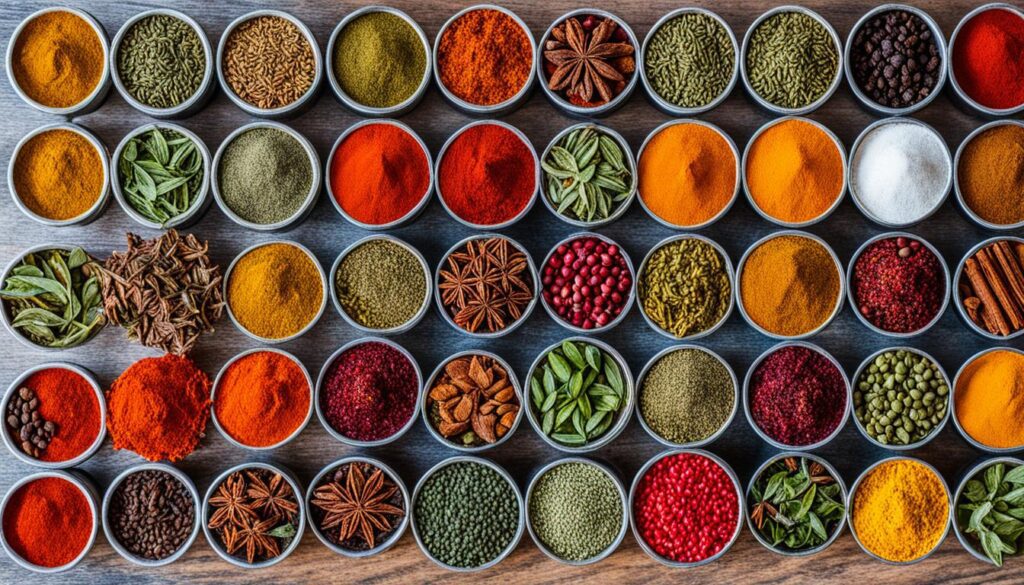
Ethiopian food is renowned for its bold and flavorful spices. The use of traditional Ethiopian spices like berbere, mitmita, awaze, and niter kibbeh adds depth and complexity to the cuisine.
One of the most popular Ethiopian spices is berbere, a flavorful blend of chile powder, fenugreek, ginger, garlic, cardamom, and cinnamon. Berbere is often used in Ethiopian stews, curries, and grilled dishes, lending a rich and aromatic taste.
Mitmita, a spicier version of berbere, is commonly served as a side seasoning for meat dishes. It adds a fiery kick and enhances the overall flavor profile of the cuisine.
Awaze, another famous Ethiopian spice, is a paste made by mixing berbere with oil and Ethiopian wine or whiskey. It is used as a condiment and adds a tangy and spicy element to various dishes.
Niter kibbeh, a clarified butter brewed with spices like fenugreek, cumin, and turmeric, is a key ingredient in Ethiopian cuisine. It brings a distinctive flavor and aroma to many traditional Ethiopian recipes.
These bold spices and flavors are a testament to the richness and uniqueness of Ethiopian food. They contribute to the unforgettable dining experience and make Ethiopian cuisine truly stand out.
Ethiopian Cuisine for Vegetarians and Vegans
Ethiopian cuisine offers a wide range of options for vegetarians and vegans. Whether you follow a plant-based diet or simply enjoy meat-free meals, you’ll find plenty of delicious choices to satisfy your cravings.
In Ethiopian Orthodox faith, Wednesdays and Fridays, as well as the lent period, are fasting days when vegan food is commonly consumed. This means that you can easily find vegan options during these times.
Many traditional Ethiopian dishes are inherently vegetarian-friendly. For example, shiro wat, a flavorful legume stew made with spiced chickpea flour, and misir wat, a rich red lentil stew, are both popular and widely available vegetarian options. These dishes are packed with protein and bursting with delicious flavors.
The use of flavorful spices and ingredients like onions, garlic, and tomatoes adds depth and complexity to Ethiopian plant-based dishes. The combination of these ingredients creates a symphony of tastes that will leave you wanting more.
Whether you’re a vegetarian or a vegan, Ethiopian cuisine offers a diverse range of options to explore. From hearty stews to vibrant vegetable curries, you’ll find dishes that cater to your dietary preferences without compromising on taste.
Discover the rich flavors and variety of Ethiopian cuisine, and indulge in delicious vegetarian and vegan options.
Must-Try Ethiopian Dishes
Ethiopian cuisine offers a wide array of delicious dishes that are a feast for the senses. From flavorful meats to vibrant vegetarian options, there’s something for everyone to enjoy. Here are some must-try Ethiopian dishes:
Tibs
Tibs are sautéed beef or lamb dishes that are bursting with flavor. The tender meat is cooked with a blend of aromatic spices and served with injera, a traditional Ethiopian bread. The combination of juicy meat and tangy injera creates a symphony of flavors that will leave you craving for more.
Kitfo
If you’re feeling adventurous, kitfo is a must-try dish. It is a spicy minced raw beef dish that is traditionally served with injera and accompanied by a variety of flavorful side dishes. The vibrant colors and bold flavors of kitfo make it a unique and unforgettable culinary experience.
Beyainatu
For the vegetarians out there, beyainatu is a vegetarian platter that showcases the colorful and diverse flavors of Ethiopian cuisine. This platter features a variety of vegetable dishes, curries, and lentil stews, all bursting with aromatic spices and served with injera. It’s a delightful feast for both the eyes and the taste buds.
Fuul
If you’re looking for a hearty and flavorful breakfast option, fuul is the way to go. It is a spiced fava bean stew that is often enjoyed in the morning. The combination of the creamy beans and aromatic spices creates a satisfying and comforting meal that will keep you energized throughout the day.
Doro Wot
One of the most iconic dishes in Ethiopian cuisine, doro wot is a chicken stew simmered in a rich and spicy sauce made with berbere spices. This hearty dish is often served with injera and is a true celebration of the bold flavors and culinary traditions of Ethiopia.
These must-try Ethiopian dishes are just a glimpse into the rich and diverse cuisine of Ethiopia. Whether you’re a meat lover, a vegetarian, or simply craving something new and exciting, Ethiopian cuisine has something for everyone. Explore the unique flavors and cultural traditions of Ethiopia through these delightful dishes.
Conclusion
Ethiopian food offers a unique culinary experience with its distinctive flavors and communal dining traditions. The combination of bold spices like berbere and mitmita adds depth and complexity to the cuisine, creating a memorable taste sensation.
One of the highlights of Ethiopian dining is the communal aspect, where meals are shared and enjoyed together. The use of injera as a foundation for various dishes encourages a sense of togetherness and connection, making the dining experience even more special.
Moreover, Ethiopian cuisine caters to a wide range of dietary preferences, including vegetarian and vegan options. With an abundance of flavorful and satisfying plant-based dishes, vegetarians and vegans can fully enjoy the rich tastes and textures that Ethiopian food has to offer.
Whether you’re a food enthusiast looking to explore unique flavors, a fan of communal dining experiences, or someone seeking vegetarian options, Ethiopian cuisine is a culinary journey that should not be missed. Indulge in the unforgettable dishes, embrace the communal spirit, and savor the distinct and wonderful world of Ethiopian food.

